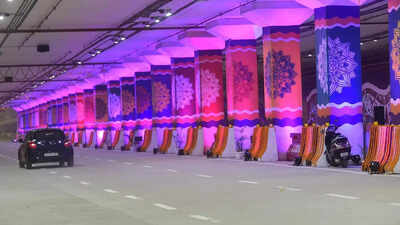Top Searches
- News
- City News
- delhi News
- Load off Delhi roads, quicker drive to Noida & Ghaziabad
Load off Delhi roads, quicker drive to Noida & Ghaziabad

According to officials, the transit route will be open between 9.30am and 8pm on the first day. The timings will be extended on the second day
NEW DELHI: The much-awaited Pragati Maidan Integrated Transit Corridor will open to the public on Monday. It will take the load off Bhairon Marg and connect India Gate to Ring Road and the NCR cities of Ghaziabad and Noida through Delhi-Meerut Expressway.
According to officials, the transit route will be open between 9.30am and 8pm on the first day. The timings will be extended on the second day.
The corridor has four underpasses on Mathura Road for vehicles to take U-turns and to avoid traffic signals on Bhagwan Das Road, Sher Shah Road, Bhairon Marg and Subramania Bharati Marg, making the stretch signal-free.
Commuters heading towards Noida and Ghaziabad can go to India Gate, enter Purana Qila Road and exit directly onto Ring Road and then take Delhi-Meerut Expressway. Earlier, people used to travel via Bhairon Marg or go all the way to ITO intersection to take the loop for Ring Road and enter the expressway. The third option was to use the Akshardham flyover to enter the expressway.
However, people coming from the NCR cities towards India Gate will still have to face detours as underpass number five will not be operational for a month, according to the estimates of the Public Works Department.
Costing around Rs 923 crore, the integrated transit network consists of a tunnel and six underpasses, which is a part of the redevelopment of the Pragati Maidan project. Keeping in mind safety measures, around 100 CCTV cameras have been installed inside the tunnel, apart from large German exhaust fans for ventilation.
The tunnel is Delhi’s widest underground six-lane stretch measuring 1.36km in length, including the ramps, and a width varying from 28.2 metres to 42 metres. It is one of the longest “box pushed” tunnels going under a seven-track railway line.
LC Goyal, chairman and managing director of India Trade Promotion Organisation, said, “The digitally controlled urban traffic tunnel has a control room, telephone and public announcement system inside. Keeping in mind waterlogging during monsoon, there are seven underground sumps to collect and remove water. The sumps are equipped with drainage pumping sensors to ensure automatic functioning.”
“Decongesting traffic in and around Pragati Maidan was necessary, primarily because visitors needed unhindered access to the trade exhibition complex,” added Goyal.
According to officials, the transit route will be open between 9.30am and 8pm on the first day. The timings will be extended on the second day.
The corridor has four underpasses on Mathura Road for vehicles to take U-turns and to avoid traffic signals on Bhagwan Das Road, Sher Shah Road, Bhairon Marg and Subramania Bharati Marg, making the stretch signal-free.
Commuters heading towards Noida and Ghaziabad can go to India Gate, enter Purana Qila Road and exit directly onto Ring Road and then take Delhi-Meerut Expressway. Earlier, people used to travel via Bhairon Marg or go all the way to ITO intersection to take the loop for Ring Road and enter the expressway. The third option was to use the Akshardham flyover to enter the expressway.
However, people coming from the NCR cities towards India Gate will still have to face detours as underpass number five will not be operational for a month, according to the estimates of the Public Works Department.
Costing around Rs 923 crore, the integrated transit network consists of a tunnel and six underpasses, which is a part of the redevelopment of the Pragati Maidan project. Keeping in mind safety measures, around 100 CCTV cameras have been installed inside the tunnel, apart from large German exhaust fans for ventilation.
The tunnel is Delhi’s widest underground six-lane stretch measuring 1.36km in length, including the ramps, and a width varying from 28.2 metres to 42 metres. It is one of the longest “box pushed” tunnels going under a seven-track railway line.
LC Goyal, chairman and managing director of India Trade Promotion Organisation, said, “The digitally controlled urban traffic tunnel has a control room, telephone and public announcement system inside. Keeping in mind waterlogging during monsoon, there are seven underground sumps to collect and remove water. The sumps are equipped with drainage pumping sensors to ensure automatic functioning.”
“Decongesting traffic in and around Pragati Maidan was necessary, primarily because visitors needed unhindered access to the trade exhibition complex,” added Goyal.
FOLLOW US ON SOCIAL MEDIA
FacebookTwitterInstagramKOO APPYOUTUBE
Looking for Something?

Start a Conversation
end of article










